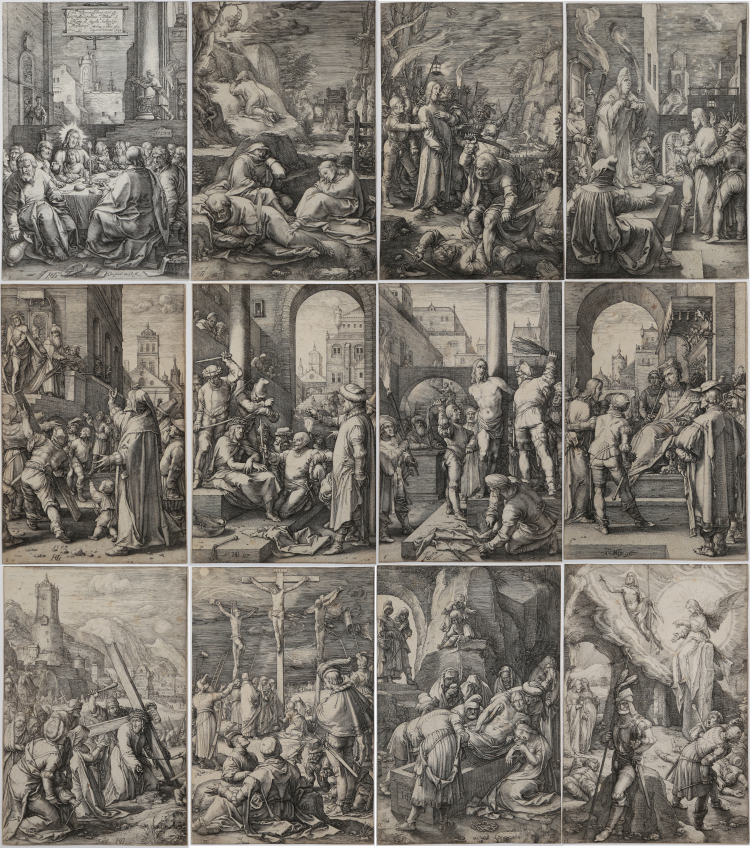















| Reference: | S5688 |
| Author | Hendrick GOLTZIUS |
| Year: | 1615 |
| Measures: | 132 x 197 mm |














| Reference: | S5688 |
| Author | Hendrick GOLTZIUS |
| Year: | 1615 |
| Measures: | 132 x 197 mm |
Engravings, 1596-98, a complete set of twelve, signed and dated on the plate, first state of two before De Wit's address.
Very fine, clear impressions, displaying a very good clarity of detail, on contemporary laid paper, watermarks "Crest of Basle in a shield" and "Coat of arms with tower" (respectively Briquet 1352 and 2291), trimmed on the platemark, lesser defects on verso, otherwise generally in very good condition.
This series was inspired and etched in the manner of Lucas van Leyden. The suite was dedicated to the cardina of Milan, Federico Borromeo, founder of the Biblioteca Ambrosiana. The dedication is on the first plate, depicting the dinner, in a scroll in the upper center: “Ill.mo Reverendissimoque Domino, D. Frederico Borromeo, Cardinali S. Mariae de Angelis, Archiepiscopo Medeolanensi. H Goltzius in debiti officij, atque amoris testimonium D.D.”.
The motivation of this dedication remains rather generic, perhaps referring to a debt of gratitude to the cardinal.
On verso collection mark of Jan Reinier Voûte (Lugt 4450)
|
Bartsch 27-38, Hollstein 21-32.
|
Hendrick GOLTZIUS (Mulbrecht 1559 - Haarlem 1617)
|
Dutch painter and engraver, was born at Millebrecht, in the duchy of Julich.
After studying painting on glass for some years under his father, he was taught the use of the burin by Dirk Volkertszoon Coornlert, a Dutch engraver of mediocre attainment, whom he soon surpassed, but who retained his services for his own advantage. He was also employed by Philip Galle to engrave a set of prints of the history of Lucretia.
At the age of twenty-one he married a widow somewhat advanced in years, whose money enabled him to establish at Haarlem an independent business; however his unpleasant relations with her so affected his health that he found it advisable in 1590 to make a tour through Germany to Italy, where he acquired an intense admiration for the works of Michelangelo, which led him to surpass that master in the grotesqueness and extravagance of his designs. He returned to Haarlem considerably improved in health, and laboured there at his art till his death.
Goltzius ought not to be judged chiefly by the works he valued most, his eccentric imitations of Michelangelo. His portraits, though mostly miniatures, are master-pieces of their kind, both on account of their exquisite finish, and as fine studies of individual character. Of his larger heads, the life-size portrait of himself is probably the most striking example. His master-pieces, so called from their being attempts to imitate the style of the old masters, have perhaps been overpraised.
In his command of the burin Goltzius is not surpassed even by Dürr; but his technical skill is often unequally aided by higher artistic qualities. Even, however, his eccentricities and extravagances are greatly counterbalanced by the beauty and freedom of his execution. He began painting at the age of forty-two, but none of his works in this branch of art--some of which are in the imperial collection at Vienna--display any special excellences. He also executed a few pieces in chiaroscuro.
|
|
Bartsch 27-38, Hollstein 21-32.
|
Hendrick GOLTZIUS (Mulbrecht 1559 - Haarlem 1617)
|
Dutch painter and engraver, was born at Millebrecht, in the duchy of Julich.
After studying painting on glass for some years under his father, he was taught the use of the burin by Dirk Volkertszoon Coornlert, a Dutch engraver of mediocre attainment, whom he soon surpassed, but who retained his services for his own advantage. He was also employed by Philip Galle to engrave a set of prints of the history of Lucretia.
At the age of twenty-one he married a widow somewhat advanced in years, whose money enabled him to establish at Haarlem an independent business; however his unpleasant relations with her so affected his health that he found it advisable in 1590 to make a tour through Germany to Italy, where he acquired an intense admiration for the works of Michelangelo, which led him to surpass that master in the grotesqueness and extravagance of his designs. He returned to Haarlem considerably improved in health, and laboured there at his art till his death.
Goltzius ought not to be judged chiefly by the works he valued most, his eccentric imitations of Michelangelo. His portraits, though mostly miniatures, are master-pieces of their kind, both on account of their exquisite finish, and as fine studies of individual character. Of his larger heads, the life-size portrait of himself is probably the most striking example. His master-pieces, so called from their being attempts to imitate the style of the old masters, have perhaps been overpraised.
In his command of the burin Goltzius is not surpassed even by Dürr; but his technical skill is often unequally aided by higher artistic qualities. Even, however, his eccentricities and extravagances are greatly counterbalanced by the beauty and freedom of his execution. He began painting at the age of forty-two, but none of his works in this branch of art--some of which are in the imperial collection at Vienna--display any special excellences. He also executed a few pieces in chiaroscuro.
|